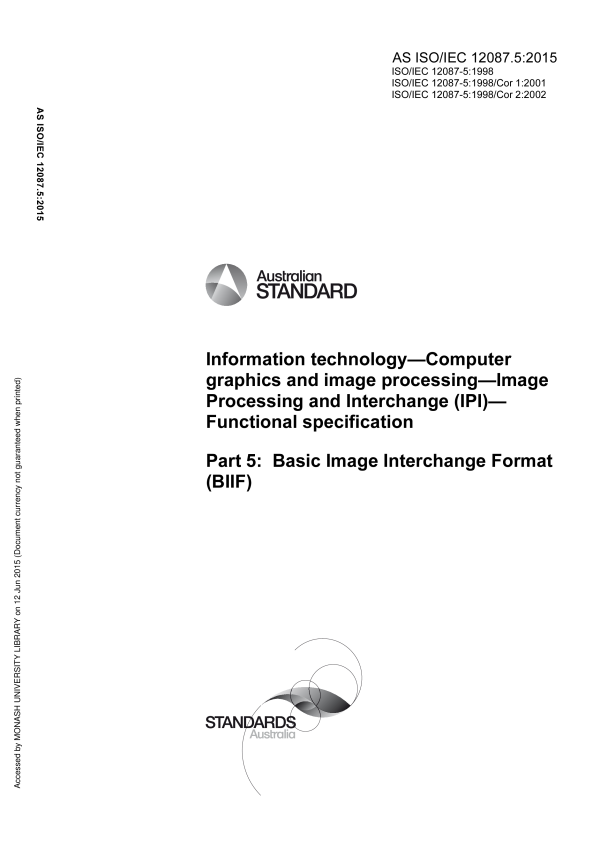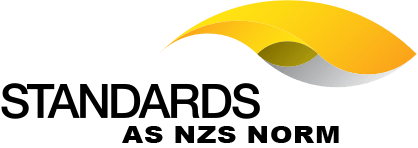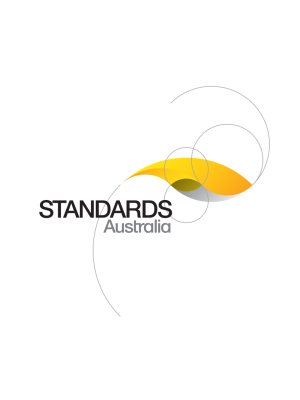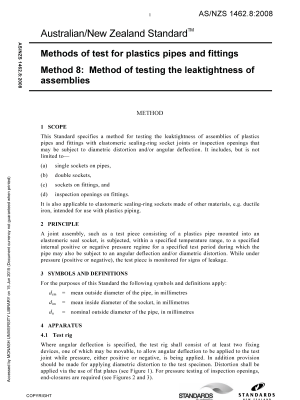🔍

Purchase the full subscription package now and enjoy a 40% discount, along with free updates for future editions.
AS ISO/IEC 12087.5:2015
$355.36
Information technology — Computer graphics and image processing — Image Processing and Interchange (IPI) — Functional specification, Part 5: Basic Image Interchange Format (BIIF)
Adopts ISO/IEC 12087-5:1998 which establishes the specification of the Basic Image Information Image Format (BIIF).
Table of contents
Header
About this publication
Preface
1 Scope
2 Normative references
3 Terms, definitions and abbreviations
3.1 Definitions
3.2 Abbreviations:
4 Basic Image Interchange Format (BIIF) specification
4.1 Format overview
4.1.1 Description
4.1.1.1 Format fields
4.1.1.2 Standard data types
4.1.1.3 Extensions
4.1.1.4 Transportable file structure (TFS)
4.1.1.5 Complexity Levels
4.1.2 Interoperability/exchange
4.1.3 Fields
4.1.3.1 Valid data
4.1.3.2 Date and time expressions
4.1.3.3 Representation of textual information in fields
4.1.3.3.1 Basic character set
4.1.3.3.2 Basic character set-numeric (BCS-N)
4.1.3.3.3 Basic character set-alphanumeric (BCS-A)
4.1.3.3.4 Universal multiple-octet coded character set (UCS)
4.1.3.3.5 UCS Transformation Format 8 (UTF-8)
4.1.4 Logical structure of pixel storage
4.1.4.1 Pixel coordinates
4.1.4.2 PIKS pixel coordinates
4.1.5 Common coordinate system
4.1.5.1 Common coordinate system structure
4.1.5.2 Row and column coordinates
4.1.5.3 CCS Boundaries
4.1.6 Display and attachment levels
4.1.6.1 Display levels
4.1.6.2 Attachment levels
4.2 Format
4.2.1 Data recording formats.
4.2.2 Encoding
4.2.3 Header
4.2.4 Image segment
4.2.4.1 Image subheader
4.2.4.2 Look-up tables (LUTS)
4.2.4.2.1 Gray scale look up tables (LUT)
4.2.4.2.2 Colour look-up tables (LUT)
4.2.5 Image data field format
4.2.5.1 Blocked images
4.2.5.1.1 Block size
4.2.5.1.2 Block ordering
4.2.5.1.3 Block divisibility condition
4.2.5.2 Image data masking
4.2.5.2.1 Blocked image masking
4.2.5.2.2 Pad pixel masking
4.2.5.2.3 Image data mask table
4.2.5.3 Compressed image data format
4.2.5.4 Uncompressed image data format
4.2.5.4.1 Single band image uncompressed data format
4.2.5.4.2 Multiple band image uncompressed data format
4.2.5.4.2.1 Band sequential
4.2.5.4.2.2 Band interleaved by pixel
4.2.5.4.2.3 Band interleaved by block
4.2.5.4.2.4 Band interleaved by row
4.2.5.5 Vector quantized data
4.2.5.6 Number of bands (NBANDS)
4.2.5.7 PIKS Objects
4.2.5.8 Image representation
4.2.6 Symbol segment
4.2.6.1 Symbol subheader
4.2.6.2 Symbol data
4.2.7 Text information segment
4.2.7.1 Text subheader
4.2.7.2 Text
4.2.8 Data Extensions
4.2.8.1 Tagged Record Extensions (TRE): Public and Private.
4.2.8.2 Data extension segments (DES)
4.2.8.3 Defined DESs
4.2.8.3.1 TRE_OVERFLOW DES
4.2.8.3.2 TRANSPORTABLE_FILE_STRUCT DES
4.2.8.4 Reserved extension segments (RES)
5 Conformance profiles and extensions
5.1 Profiles
5.2 Profile specific header/subheader dependencies proforma
5.3 Complexity level proforma
5.4 Implementation support requirements
5.4.1 General support requirements
5.4.2 Producing and interpreting BIIF files
5.4.2.1 Producing BIIF files
5.4.2.2 Interpreting BIIF files
5.5 Defined extensions
5.6 Profile registration
Annex A
A.1 Transportable file structure (TFS)
A.1.1 TFS Commands
A.1.2 TFS encoding
A.1.3 TFS command flow
A.2 TFS command formats
A.2.1 TFS delimiter commands
A.2.1.1 Begin TFS command
A.2.1.2 Begin transport command
A.2.1.3 Begin transport body command
A.2.1.4 Begin transport profile command
A.2.1.5 Begin transport profile body command
A.2.1.6 End transport profile command
A.2.1.7 End transport command
A.2.1.8 End TFS command
A.2.2 TFS descriptor commands
A.2.2.1 TFS version command
A.2.2.2 TFS security command
A.2.2.3 TFS subscription command
A.2.2.4 TFS configuration command
A.2.2.5 TFS configuration data command
A.2.2.6 TFS metadata command
A.2.2.7 TFS index command
A.2.3 Transport descriptor commands
A.2.3.1 Transport security command
A.2.3.2 Transport metadata command
A.2.3.3 Transport index command
A.2.4 Transport Profile descriptor commands
A.2.4.1 Transport Profile security command
A.2.4.2 Transport profile metadata command
A.2.4.3 Transport profile index command
A.2.5 Transport profile commands
A.2.5.1 Transport profile action command
A.2.5.2 Transport profile object command
A.2.5.2.1 Transport Profile object command parameters for PIKS objects
A.2.6 TFS escape command
Annex B
B.1 Vector Quantized Data
B.2 Quantization Process
B.3 Reconstruction
B.3.1 Spatial reconstruction
B.3.2 Color reconstruction
B.3.3 Data elements
B.3.3.1 Quantization ratio
B.3.3.2 Masked vs unmasked
B.3.3.3 Code book organization
B.3.3.4 Spatial data section
B.4 File organization
B.5 Definitions – image data section
B.6 Definitions – BIIF header and image subheader
Annex C
C.1 Profiling process
C.2 Profile proforma
C.2.1 Use of the model profile
C.2.2 Rules for filling out the proforma tables
C.2.2.1 Profile Tables
C.2.2.1.1 BIIF File Header
C.2.2.1.2 BIIF security fields
C.2.2.1.3 BIIF image subheader fields
C.2.2.1.4 BIIF image data mask table
C.2.2.1.5 BIIF symbol subheader
C.2.2.1.6 BIIF text subheader
C.2.2.1.7 BIIF tagged record extensions (TREs)
C.2.2.1.8 BIIF data extension segments
C.2.2.1.9 BIIF reserved extension segments
C.2.2.1.10 TFS Profile Proforma
C.2.2.1.11 Implementation Support Requirements
Annex D
D.1 Implementation considerations and product configurations
D.2 TRE_OVERFLOW example
D.3 Scope of implementation
D.3.1 Creating headers and subheaders
D.3.2 Character counts
D.3.3 Data entry
D.3.4 Tagged Record Extensions
D.3.5 Out-of-bounds field values
D.3.6 Use of images
D.3.7 Use of text files
D.3.7.1 BCS (TXTFMT=STA)
D.3.7.2 Additional TXTFMT Codes
D.3.8 File system constraints
D.3.9 Security considerations
D.4 Product configurations
D.4.1 General
D.4.1.1 Single file, single base image
D.4.1.1.1 Image segment overlays
D.4.1.1.2 Graphic segment overlays
D.4.1.1.3 Non-destructive overlays
D.4.1.1.4 Text Segments
D.4.1.1.5 Extension data
D.4.1.2 Single file, multiple images
D.4.1.2.1 Overlays
D.4.1.2.2 Text segments
D.4.1.2.3 Extension data
D.4.1.3 Single file, no image
D.4.1.4 Multiple correlated files
D.4.1.4.1 Stereo imagery
D.4.1.4.2 Imagery mosaics
D.4.1.4.3 Reduced resolution data sets (rsets)
D.4.1.4.4 Imagery and maps
Annex E
E.1 Example file
E.1.1 Use of this example
E.1.2 BIIF Model Profile for example file
E.1.2.1 Explanation of the file header
E.1.2.2 Explanation of the image subheaders
E.1.2.2.1 Explanation of the first image subheader
E.1.2.2.2 Explanation of the second image subheader
E.1.2.3 Explanation of the symbol subheaders
E.1.2.3.1 Explanation of the first symbol subheader
E.1.2.3.2 Explanation of the second symbol subheader
E.1.2.3.3 Explanation of the third Symbol subheader
E.1.2.3.4 Explanation of the fourth symbol subheader
E.1.2.3.5 Explanation of the fifth symbol subheader
E.1.2.4 Explanation of the text subheaders
E.1.2.4.1 Explanation of the first text subheader
E.2 Examples using the Transportable File Structure (TFS)
E.2.1 Use of TFS
E.2.2 TFS Examples
E.2.2.1 TFS example of PIKS processing for an image
E.2.2.2 TFS example of requesting imagery and patient history
E.2.2.3 TFS example of using configuration and a five band image
E.3 Open Skies Digital Data Exchange Profile example (Informative)
E.3.1 Open Skies Digital Data Exchange File Header
E.3.2 Open Skies Image Data Subheader
E.3.3 Open Skies SAR Information
E.3.4 Open Skies Text Data Subheader
E.3.5 Open Skies Annotation Text Format 1
E.3.6 Data Extension Segment Subheader
E.3.7 Open Skies Digital Data Exchange Format (OSDDEF) DCRsi TAPE ANNOTATION and TAPE DIRECTORY File
E.3.8 Example Entries in Data and Field Tables
Technical corrigendum 1
Technical corrigendum 2
Cited references in this standard
Content history
[Superseded]
[Superseded]
[Superseded]
ISO/IEC 12087-5:1998/Cor 2:2002
ISO/IEC 12087-5:1998/Cor 1:2001
Please select a variation to view its description.
| Published | 12/05/2015 |
|---|---|
| Pages | 167 |
Please select a variation to view its pdf.



